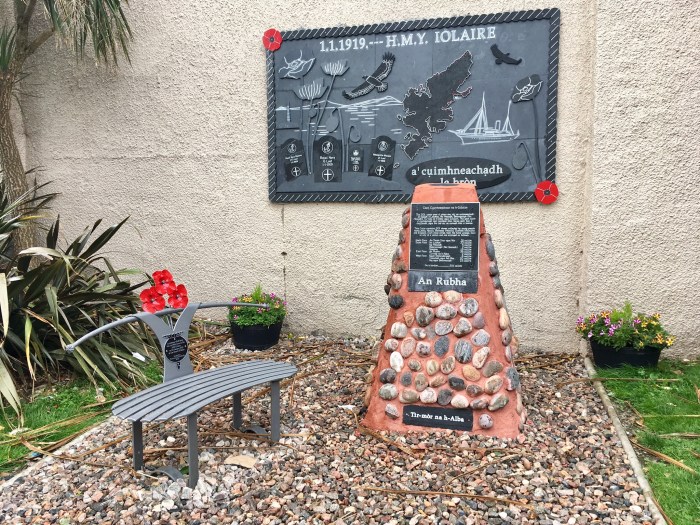Hebridean Hop 3: Callanish and beyond
Monday 30th July 2018

Our day began close to our hotel at a memorial to those who died on HMY Iolaire, a terrible tragedy which hit the island of Lewis just after the close of World War 1. Over 200 returning soldiers drowned on New Year’s Day 1919 when the yacht hit rocks just a mile from Stornoway Harbour. Each stone on the monument signifies a township which lost someone, a very sad representation.
From Stornoway, we made a circular tour taking in some of the main archeological sites of the island. The most famous of all is Callanish (Calanais) where the standing stones are believed to be older than both Stonehenge and the Pyramids of Giza. We last visited as part of an earlier island-hopping holiday in 1989 (then and now pictures below).
What has changed? I don’t remember a Visitor Centre in 1989 – this year, the first thing we did was have coffee in the Visitor Centre Café. Like our visit to Orkney and Shetland a few years ago, in that case after a gap of 20 years, tourist infrastructure has come on in leaps and bounds in the intervening decades.
 There are far more tourists (though it might not always look it from the photographs) but it’s still possible to see the same people all the time. In Callanish, we recognised several groups who had been on the same ferry. A Swiss couple took the table next to us at coffee. When we had lunch at another site later, they took the table behind us, and when we had dinner at night they were already in the restaurant. This type of thing happened again and again, to the extent that we greeted some people with a cheery hello as if they were long-lost friends!
There are far more tourists (though it might not always look it from the photographs) but it’s still possible to see the same people all the time. In Callanish, we recognised several groups who had been on the same ferry. A Swiss couple took the table next to us at coffee. When we had lunch at another site later, they took the table behind us, and when we had dinner at night they were already in the restaurant. This type of thing happened again and again, to the extent that we greeted some people with a cheery hello as if they were long-lost friends!
A short circular walk took us to two lesser stone circles (above), Callanish II and Callanish III, before we headed off to our next stop, Geàrrannan Blackhouse Village. I believe the correct term in estate agent language for the house in the background of Callanish II is “potential”.
Blackhouses were the most common living quarters for islanders right into the 20th century. Made of stone, turf and straw thatch, one end was for people and the other end for cattle. Nine houses have been restored at Geàrrannan, some providing (much modernised) holiday accommodation and the rest the museum and its facilities (where we had our excellent lunch).
The interior above shows how the houses would have looked in the 1950s or 60s – by the 1970s, only a few ageing residents were left and in 1974 they moved to new council houses nearby. As the Trust which took over the deteriorating buildings wasn’t formed until 1989, this was a new museum for us.
After lunch, we backtracked slightly to Dun Carloway, one of the best preserved Iron Age forts in Scotland.
We then stopped at a restored Norse Mill in Dalbeg, before visiting another blackhouse museum at Arnol. This we remembered from 1989, and wondered how its visitor numbers had since been affected by the more extensive Geàrrannan.
 It might seem shocking that people lived in blackhouses until the mid-late 20th century. In 1989, it must have been unusual as we have made a point of snapping this one which is obviously still occupied because it has smoke coming out of the chimney. However things come full circle, and on our travels this year we spotted many which had been restored extensively, like the holiday cottages at Geàrrannan, some of which seemed to be private dwellings. I’d love to see inside – they must be cosy with such thick walls, but I’m not sure I’d like to live in one permanently.
It might seem shocking that people lived in blackhouses until the mid-late 20th century. In 1989, it must have been unusual as we have made a point of snapping this one which is obviously still occupied because it has smoke coming out of the chimney. However things come full circle, and on our travels this year we spotted many which had been restored extensively, like the holiday cottages at Geàrrannan, some of which seemed to be private dwellings. I’d love to see inside – they must be cosy with such thick walls, but I’m not sure I’d like to live in one permanently.
From Arnol, we drove back to our hotel in Stornoway. We had one more day on Lewis to come.




















![Top-20-Travel-Blogs-200×150[1]](https://i0.wp.com/www.holiday365.co.uk/blog/wp-content/uploads/2012/06/Top-20-Travel-Blogs-200x1501.png)
Dear Glasgow Gallivanter, wonder if we can use your image of the Iolaire Memorial in a commemorative booklet we are designing. It has no commercial use and is being produced for school children on Lewis. We will credit, of course. Please let me know if you have any problems with that. Regards,
Andrew Wolffe (andrew@wolffedesign.com)
LikeLike
That sounds a great project! I’ll drop you an email shortly.
LikeLike
Thanks for the fascinating tour. I remember seeing some similar round stone houses in the south and west of Ireland when I visited in 2005, and also some much smaller stone circles.
Jude
LikeLike
Yes, there are great similarities between Scotland and Ireland.
LikeLike
You had such a delightful trip. So many amazing photographs, I so enjoy them.
LikeLike
Thank you, we had a wonderful time and I’m enjoying it all over again with these posts!
LikeLiked by 1 person
Oh, what a terrible tragedy! Those poor returning soldiers and their expectant families waiting in vain for their return. It doesn’t bear thinking about. Those ancient standing stones are amazing. Imagine the times they’ve seen! Thanks for the free tour, Anabel. 🙂
LikeLike
I know, it’s appalling! So close to the shore too.
LikeLiked by 2 people
Interesting, Anabel, how old these standing stones are! I could imagine spending my holidays in such a cottage – with all modern amenities, of course.
LikeLiked by 1 person
Me too! With VERY modern amenities.
LikeLiked by 1 person
Agreed!
LikeLiked by 1 person
Looks so lovely and fascinating. Love the house with “potential.” Actually I would love to see the stone circles and the fort.
LikeLike
“Potential” is a bit of a running joke with us! That one definitely had it.
LikeLiked by 1 person
All places new to me. I’ve been in a few blackhouses over the years. Not that different from some basic bothies I’ve stayed in and fairly cosy once you have a fire going compared to the weather and midges outside. Scottish standing stones are very ‘in’ at the moment worldwide thanks to the power of Outlander.
LikeLike
I did think of you and your bothies! I haven’t seen or read Outlander. But you really can’t escape it.
LikeLike
Thank you for the tour – I’m really enjoying seeing parts of my own homeland through your eyes.
LikeLike
Glad you are enjoying it!
LikeLike
It’s great – touring all over the place from the comfort of my chair. 🙂
LikeLiked by 1 person